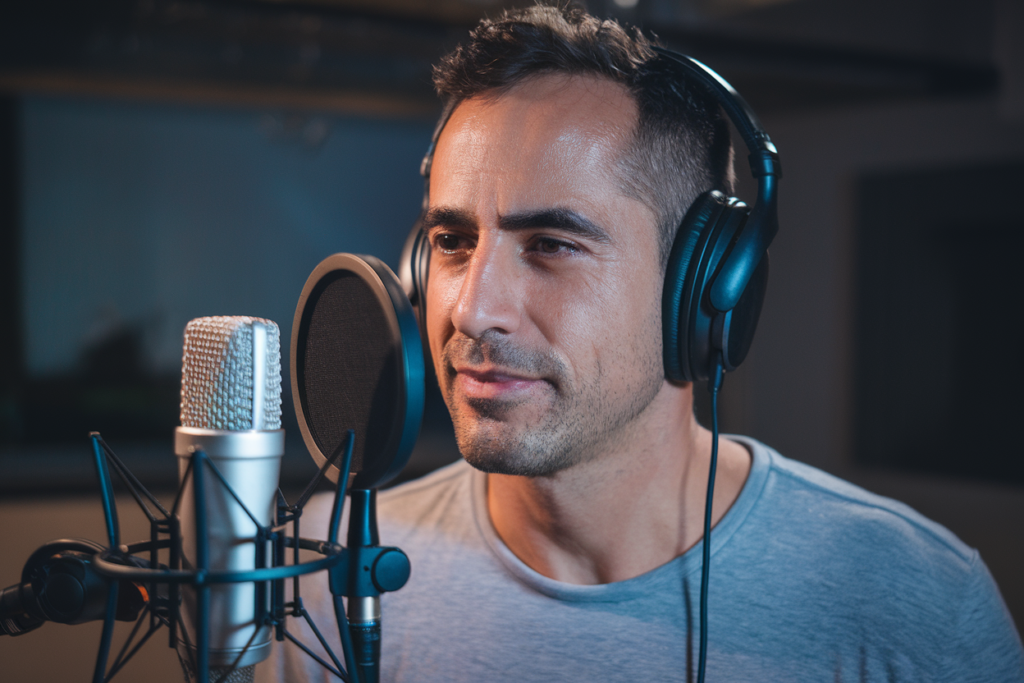Directing Castilian Spanish voice actors can be a rewarding yet challenging experience. With its rich cultural nuances and distinct pronunciation, capturing the essence of this language requires more than just technical skills; it demands an understanding of the subtleties that make it unique. Whether you’re working on an animated film, video game, or commercial, knowing how to effectively communicate your vision is key.
Key Takeaways
- Understand Unique Characteristics: Familiarize yourself with the distinct pronunciation, vocabulary, and rhythm of Castilian Spanish to ensure authentic voice performances.
- Emphasize Cultural Context: Recognize regional variations and cultural references that influence performance styles to better connect with local audiences.
- Prepare Thoroughly: Conduct a detailed script analysis and understand various voice acting techniques for effective direction during recordings.
- Communicate Effectively: Use clear language when conveying your vision to voice actors, setting specific objectives while allowing creative exploration.
- Build Rapport and Trust: Foster open communication and show appreciation to create a supportive environment that enhances collaboration with voice talent.
- Focus on Recording Best Practices: Ensure an optimal recording environment and manage session dynamics effectively for high-quality outcomes in voice performances.
Understanding Castilian Spanish Voice Acting
Understanding Castilian Spanish voice acting involves recognizing its unique characteristics and the cultural context that shapes performances. This knowledge enhances communication between you and the voice actors, ensuring an authentic representation of your project’s vision.
Characteristics of Castilian Spanish
Castilian Spanish features distinct pronunciation, vocabulary, and intonation. Key characteristics include:
- Seseo vs. Ceceo: Recognize that in most regions of Spain, “c” before “e” or “i,” as well as “z,” are pronounced with a soft “th” sound.
- Phonetic Clarity: Expect clearer enunciation compared to Latin American Spanish, which influences how voice actors deliver lines.
- Rhythm and Melody: Understand the rhythmic patterns unique to Castilian speech; this affects pacing in recordings.
These elements contribute significantly to the overall quality of voiceovers, impacting how audiences perceive your content.
Importance of Cultural Context
Cultural context plays a vital role in directing Castilian Spanish voice talent effectively. Key points include:
- Regional Variations: Be aware of regional dialects within Spain that may influence performance styles; this can guide casting decisions.
- Cultural References: Incorporate culturally relevant themes into scripts to resonate better with local audiences; this enhances relatability.
- Emotional Nuance: Understand emotional expressions tied to specific cultural situations; effective direction requires conveying these nuances accurately.
By grasping these aspects, you can direct voice artists more effectively, ensuring their performances align with your project’s goals while respecting the cultural background they represent.
Preparing for the Directing Process
Preparing for the directing process involves thorough planning and understanding of your project. This preparation enhances collaboration with voice actors, ensuring that their performances align with your vision.
Script Analysis
Script analysis serves as a crucial first step in directing voice talent. Identify key themes, character arcs, and emotional cues within the script. Break down dialogue into segments based on tone, pacing, and intention. Highlight specific phrases where pronunciation nuances matter, particularly in Castilian Spanish. By recognizing these elements early on, you can provide targeted direction that helps voice actors deliver authentic performances.
Understanding Voice Acting Techniques
Understanding various voice acting techniques significantly impacts how you direct voice artists. Familiarize yourself with techniques such as emotional delivery, breath control, and vocal modulation. Encourage voice actors to explore different character interpretations while remaining true to the script’s essence. Discuss the importance of clear articulation in Castilian Spanish; this clarity enhances audience comprehension and engagement during recordings. Emphasizing these techniques ensures that your direction maximizes each performance’s potential while aligning with cultural nuances unique to this dialect.
Communicating with Voice Actors
Effective communication with voice actors is crucial for achieving the desired performance. Clarity in conveying your vision ensures that voice talent understands their role and expectations. Use specific language when discussing character traits, emotional tones, and delivery styles to avoid ambiguity.
Effective Direction Techniques
Utilize various techniques to guide voice actors toward optimal performances:
- Provide Context: Share the background of the project and character motivations to help voice artists connect emotionally.
- Set Clear Objectives: Outline what you aim to achieve with each scene or line, focusing on tone and pacing.
- Encourage Exploration: Allow flexibility for voice actors to experiment with their delivery. This can lead to unexpected but beneficial interpretations.
- Use Reference Material: Share examples of similar projects or performances, helping voice over talent grasp the desired style more effectively.
Building Rapport and Trust
Establishing a positive relationship with voice actors enhances collaboration:
- Foster Open Communication: Create an environment where talent feels comfortable asking questions or expressing concerns about their performances.
- Show Appreciation: Acknowledge the efforts made by voice artists during sessions. Positive reinforcement encourages them to deliver their best work.
- Be Respectful of Time: Value each actor’s schedule by staying organized and efficient during recording sessions. This builds trust and respect between you and the performers.
- Incorporate Feedback Loops: Encourage feedback both ways; listen actively to suggestions from your voice over talent. This collaborative approach fosters mutual respect and improves overall outcomes.
By prioritizing clear communication, effective direction techniques, and rapport building, you’ll enhance interactions with Castilian Spanish voice actors while ensuring high-quality results in your projects.
Recording Sessions Best Practices
Recording sessions require attention to detail for optimal outcomes. Creating a conducive environment and managing dynamics effectively enhances the performance of voice actors.
Setting Up the Recording Environment
Setting up the recording space is essential for quality sound capture. Ensure that the room has soundproofing elements like acoustic panels or carpets to minimize echoes and ambient noise. Use high-quality microphones suited for voiceovers, as they capture nuances in delivery and emotion. Check equipment functionality before starting; this includes testing microphones, headphones, and recording software.
Maintain an organized setup with comfortable seating arrangements for voice talent. Provide clear sightlines between you and the actor to facilitate communication during takes. Keep water available to help voice artists stay hydrated throughout long sessions, ensuring their vocal cords remain in top condition.
Managing Session Dynamics
Managing session dynamics plays a crucial role in achieving desired performances. Begin each session by outlining objectives clearly to your voice talent, emphasizing character traits, emotional tones, and specific delivery styles required for different scenes or lines.
Encourage open dialogue with actors during recordings by asking for their input on interpretations or suggesting adjustments when necessary. Foster a supportive atmosphere where talent feels comfortable exploring different approaches without fear of judgment. Utilize reference materials—such as clips from previous projects or examples of desired tone—to guide performances effectively.
Implement feedback loops where you provide constructive criticism while allowing room for improvisation or creative interpretation from the voice artist. This collaboration results in richer performances that resonate more deeply with audiences while remaining true to your project’s vision.
Post-Production Considerations
Post-production plays a critical role in bringing the performance of voice actors to life. It involves several key elements that enhance the final product and ensure it aligns with your project’s vision.
Editing and Sound Design
Editing requires careful attention to detail. You’ll want to cut, rearrange, and refine recordings while maintaining the natural flow of dialogue. Focus on removing any unwanted noise or interruptions that could distract from the delivery of the voice talent. Utilize audio editing software to adjust levels, balance frequencies, and enhance clarity.
Sound design complements voiceovers by adding layers that enrich storytelling. Integrate sound effects and background music harmoniously with vocal performances to create an immersive experience for your audience. Ensure these elements support rather than overshadow the voice artist’s work.
Feedback and Revisions
Feedback is essential for refining performances. After initial edits, share drafts with stakeholders for input regarding tone, pacing, and emotional impact. Encourage constructive criticism from collaborators who understand your project’s goals.
Incorporating feedback may lead to necessary revisions in voice tracks or additional recording sessions with voice actors. This iterative process ensures that every aspect meets quality standards before finalizing the project. By prioritizing open communication during this phase, you foster collaboration that enhances overall production quality.
Conclusion
Directing Castilian Spanish voice actors requires a blend of cultural understanding and effective communication. By grasping the nuances of the language and its distinct pronunciation you can guide your talent to deliver authentic performances that resonate with audiences.
Building rapport and trust is essential for creating a collaborative environment. Encourage open dialogue and show appreciation for their craft as this fosters creativity and enhances performance quality.
Finally paying attention to post-production details will ensure that every voice recording aligns with your project’s vision. With these strategies in place you’re well on your way to achieving exceptional results in your voice acting projects.
Frequently Asked Questions
What is the main focus of directing Castilian Spanish voice actors?
Directing Castilian Spanish voice actors requires an understanding of cultural nuances, distinct pronunciation, and effective communication to convey a director’s vision. This is particularly important in projects like animated films, video games, and commercials where authenticity matters.
How does pronunciation affect voice delivery in Castilian Spanish?
Pronunciation differences such as seseo vs. ceceo can significantly impact phonetic clarity and rhythmic speech patterns, which influence how lines are delivered. Understanding these characteristics helps directors guide performances that resonate with audiences.
Why is cultural context important in voice acting direction?
Cultural context shapes regional dialects, themes, and emotional nuances that enrich performances. Acknowledging these elements helps directors communicate effectively with voice talent for more authentic portrayals aligned with the project’s vision.
What preparation is needed before directing voice actors?
Preparation involves thorough planning and script analysis. Directors should identify key themes, character arcs, emotional cues, and break down dialogue based on tone to guide their approach during recording sessions.
What techniques enhance communication with voice actors?
Effective techniques include providing clear context for scenes, setting specific objectives for performances, encouraging exploration of characters’ emotions, and using reference materials to clarify desired outcomes.
How can directors build rapport with voice talent?
Building rapport involves open communication, appreciating actors’ efforts respectfully while valuing their time. Incorporating feedback loops fosters collaboration and ensures that both parties work towards a shared vision seamlessly.
What are best practices for recording sessions?
Best practices include setting up a soundproof environment with quality equipment while managing session dynamics by outlining objectives clearly. Encouraging dialogue creates a supportive atmosphere conducive to exploring different performance styles.
How does post-production contribute to enhancing voice performances?
Post-production plays a critical role in refining recordings through careful editing and sound design. Integrating sound effects enhances immersion while collaborative feedback ensures the final product meets quality standards aligned with the project’s goals.






